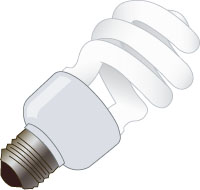About Mercury

Mercury is a chemical element. Although it is a metal, it is a liquid at room temperature. Its chemical properties make it a useful substance for a variety of electronic devices and industrial applications, but Mercury is also highly toxic to humans. As a pollutant, mercury stays in the environment for a very long time.
Mercury in Your Home
Mercury is often used in everyday household objects, some of these assorted items that may contain mercury are:
- Kids toys and miscellaneous items
- Fever thermometers and antiseptic products that contain thimerosal or merbromin
- Fluorescent lights and Mercury vapor lamps
- Dental amalgams (used to fill cavities) contain mercury
- Oil-based paint that contains mercury and some latex paints made before 1990
- Mercury thermostats
- Clothes irons
- Pilot light sensors found in gas appliances such as stoves, furnaces, and water heaters
- Gauges found in barometers and blood pressure gauges
- Mercury switches may be used in chest freezers, refrigerators, gas and electric stoves, washing machines, space heaters, pool heaters, commercial water heaters, and camper appliances.
- Scientific apparatus, such as gauges and barometers
- Many automotive applications including hood and trunk light switches, ABS braking systems switches, ride control systems, navigation displays, air bag sensors, and high intensity discharge (HID) headlamps.
Mercury containing items should never be discarded in the general trash or garbage. Proper repair practices or disposal will reduce the potential risks of exposure by humans and impact to the environment.
Concerns About Mercury
Although mercury performs many useful functions, it is toxic and is one of the primary pollutants of concern in Indiana because:
- Mercury can impair the way we see, hear and function.
- Mercury poisoning can attack the central nervous system in humans and cause irreversible brain, liver, and kidney damage.
- Women of child-bearing age and children, especially those under the age of six, are are the most sensitive to mercury toxicity and most susceptible to mercury poisoning.
- Mercury does not breakdown to less toxic forms in the environment. A percentage of mercury undergoes a biological/chemical process and is converted to methylmercury, which is a more toxic form of mercury.
- Significant quantities of mercury have been found in many Indiana streams and species of fish in Indiana.
Safe Disposal of Mercury Containing Items
You should never put mercury in the trash. Mercury containing items can be safely collected, recycled, or disposed of in an approved waste disposal facility.
Things to remember when disposing of objects containing mercury:
- Never break open items that contain mercury
- Never pour mercury down the drain
- Never burn mercury
- Never put mercury in the trash
Identify all the assorted items that contain mercury.
- Use stickers or some other form of identification to mark them, and replace as necessary.
- Contact IDEM for free mercury stickers.
Properly dispose assorted mercury items - recycle them!
- Once you've gathered all the outdated mercury-containing toys, shoes, paint, batteries and antibacterial products from your home, place them in a sealable, plastic container and mark it "Mercury for Recycling."
- Take it to your local mercury recycling site, such as your local solid waste management district, or in Marion County, contact the ToxDrop.
Before you buy, check what's inside.
- Do not buy mercury-containing products unless they are absolutely necessary.
Mercury Spill: What to Do
When liquid (elemental) mercury is spilled, it forms beads or droplets that can accumulate in the tiniest places. These droplets can emit vapors into the air that we cannot see or smell. Breathing mercury vapors can be very dangerous, depending on how much mercury is in the air and how long you are exposed the contaminated air. Small children and pregnant women are at highest risk for mercury poisoning, but mercury poisoning can impact anyone.
Most small mercury spills, such as those from fever thermometers, can be cleaned up easily. The small amount of elemental mercury in fever thermometers and thermostats is not likely to cause serious health problems if it is immediately cleaned up.
Even tiny mercury spills must be cleaned up properly.
- Please follow the instructions for cleaning up a small household mercury spill [PDF].
- If you spill more mercury than the amount in a fever thermometer, report the spill to IDEM.
- Never use a vacuum cleaner or shop vac to clean up a mercury spill! If a thermometer breaks on a smooth surface, use two pieces of paper to scoop all the tiny beads into a sealable, plastic container.
- If necessary, use an eye dropper to capture the beads of mercury.
- Wipe area with a damp sponge.
- All cleanup material, including paper, eye dropper and sponge, as well as any contaminated rug or portion of carpet must be properly disposed with the mercury.
- Put everything in marked plastic containers and take them to a local mercury recycling site.
- If human contact with mercury occurs, call the Indiana Poison Center.
Additional Resources
Consumers
- Mercury Spill Guidance [PDF]
- IDEM Lighting Alternatives Fact Sheet (available on the IDEM Fact Sheets page)
- Mercury Regulations and Related Programs at IDEM
